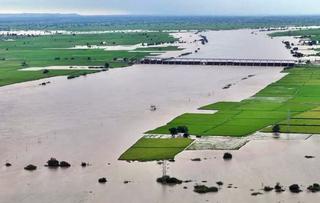The devastation caused by incessant rains and floods in Kalaburagi district has reached alarming proportions, forcing the Chief Minister to personally undertake an aerial inspection to gauge the scale of destruction. Flying over submerged villages, washed-out roads, and vast stretches of ruined farmlands, the CM witnessed firsthand the plight of residents whose lives have been thrown into disarray. The survey was aimed at assessing not only crop losses but also the extent of displacement, with thousands of families taking shelter in relief camps.
During the inspection, the Chief Minister expressed grave concern over the agricultural impact, as crops such as tur dal, sunflower, and cotton have been wiped out across thousands of acres. Farmers, who were already under economic stress due to fluctuating prices and debts, now find themselves on the brink of ruin. The CM reassured the farming community that the government would extend financial relief and ensure timely compensation. He also pledged to seek central aid to address the scale of the disaster, emphasizing that no farmer should feel abandoned in this critical hour.
Local officials briefed the CM on the rescue and rehabilitation operations underway. As many as 6,664 people have been evacuated so far, with 53 relief centers providing food, water, and medical facilities. The administration has also deployed teams for road repair, power restoration, and disease prevention measures in flood-hit areas. The CM, while interacting with affected families, acknowledged their hardships and promised quick implementation of crop insurance payouts and long-term rehabilitation packages.

Immediate Relief and Government Response
The Chief Minister directed district authorities to prioritize the distribution of essentials such as food grains, drinking water, and medical kits. He also ordered a rapid assessment of houses that had been damaged or destroyed, so that compensation could be disbursed at the earliest. Special instructions were given to health officials to prevent the outbreak of waterborne diseases, with mobile health units deployed in flood-hit areas to provide timely care.
Alongside immediate measures, the CM announced that the government would be sending teams from the agriculture department to survey affected farmlands, document crop damage, and expedite claims under the crop insurance scheme. Financial aid packages, he stressed, would be structured to directly benefit small and marginal farmers, who face the highest vulnerability during such disasters.
The aerial survey provided a comprehensive view of the widespread devastation that ground reports had only partially captured. Entire clusters of villages appeared like islands surrounded by floodwaters, and many connecting roads had been cut off, leaving residents stranded. The Chief Minister noted that while relief efforts were progressing, the sheer geographical spread of the flood posed challenges for delivering timely assistance. Helicopters and boats were being used in several inaccessible pockets to provide rations and evacuate stranded families.
The agricultural setback in Kalaburagi is being described as one of the worst in recent years. Farmers had invested heavily in this season’s sowing, hoping for good returns after enduring previous drought spells. However, excessive rainfall and flooding have destroyed crops at the growth stage, leaving farmers with neither produce to sell nor resources to reinvest. Agricultural economists warn that such extensive losses will have ripple effects on local markets, pushing up prices and increasing dependence on external supplies for essential grains and pulses.
During the inspection, the CM also spoke about the psychological toll the disaster has taken on farmers. He pointed out that repeated cycles of drought and floods have left many rural households demoralized, forcing younger generations to consider abandoning agriculture altogether. He stressed that the government’s role is not limited to financial relief but also to restoring confidence among the farming community by ensuring timely compensation and long-term agricultural support measures.
The administration in Kalaburagi has mobilized teams to collect accurate data on crop damage. Officials are mapping the extent of losses using satellite imagery alongside on-ground surveys to ensure transparency in relief distribution. Farmers’ associations, however, have urged the government to simplify compensation procedures and reduce bureaucratic hurdles. They argue that in past disasters, many small-scale farmers were excluded from benefits due to delays in paperwork or incorrect entries in revenue records.
The CM assured that this time, the process would be made more farmer-friendly. He instructed officials to directly engage with village-level representatives and farmer groups to ensure no household is overlooked. He also indicated that digital records of land holdings and crop patterns would be cross-verified with field reports to avoid duplication and corruption in relief allocation. This measure, he said, would expedite disbursement and build trust among affected communities.
Meanwhile, relief camps in Kalaburagi have been functioning under challenging circumstances. With more families pouring in every day, space and sanitation are becoming pressing concerns. Volunteers and NGOs are extending support by providing cooked meals, blankets, and hygiene kits. The district administration is also focusing on children and elderly residents, who are particularly vulnerable during such crises. Special enclosures for women and children have been set up to ensure safety and dignity within the camps.
The Chief Minister emphasized that rehabilitation is not merely about providing temporary relief but ensuring people can return to normal lives at the earliest. He stated that houses destroyed by floods would be rebuilt under housing schemes, while partial damages would be compensated based on government estimates. He highlighted that priority would be given to restoring basic infrastructure such as roads, electricity lines, and drinking water supply, which are critical for everyday survival and for restarting agricultural activity.
Experts in disaster management have recommended a more proactive approach for districts like Kalaburagi, which are increasingly prone to extreme weather events. They argue that building resilience should include creating flood-resistant crop varieties, strengthening water storage infrastructure, and training local communities in disaster preparedness. The CM, in response, announced that a task force will be set up to study these recommendations and propose actionable measures within a stipulated timeframe.
Political reactions to the floods have also begun surfacing, with opposition parties criticizing the government for not anticipating the crisis despite early warnings from the meteorological department. They argue that advance preparedness could have reduced the scale of losses. The ruling government, however, has defended its record, pointing to the speed of rescue operations and the deployment of resources as evidence of its commitment to public welfare.
The economic impact of the floods is not limited to farmers alone. Daily wage workers, transport operators, and small businesses dependent on agricultural cycles have all been affected. With rural markets disrupted, supply chains for food and essentials are struggling.
Long-Term Rehabilitation Plans
In the long run, the Chief Minister emphasized the need for building resilience against recurring floods in the region. He announced plans to strengthen embankments, improve drainage systems, and construct additional check dams to regulate water flow during heavy rains. The CM underlined that lessons from this year’s floods would be incorporated into future disaster management strategies, ensuring that Kalaburagi’s agricultural backbone is safeguarded from repeated devastation. Farmers, he concluded, would remain at the heart of the government’s relief and rehabilitation efforts, with sustained support promised until normalcy is fully restored.
The floods have not only destroyed crops but also disrupted the livelihood of thousands of agricultural laborers. Daily wage earners, who depend on farm work, now face uncertainty as submerged fields lie uncultivable for weeks. With no immediate employment opportunities, many have shifted temporarily to relief camps. Officials admitted that rehabilitation measures must include job assurance programs like MGNREGA to provide short-term income support for displaced families. Without this, the rural economy could take months to recover from the severe blow inflicted by the floods.
In addition to crop losses, the damage to infrastructure has compounded the challenges faced by residents. Several rural roads have been rendered impassable, cutting off villages from nearby towns and markets. This has not only hindered the transport of relief supplies but also delayed medical access for vulnerable populations. The Public Works Department has been instructed to mobilize emergency teams for clearing debris, repairing breaches, and laying temporary tracks to restore basic connectivity. The government is prioritizing access routes to ensure relief reaches the remotest corners of the district.
Educational institutions in Kalaburagi have also been affected, with some schools submerged and others repurposed into makeshift relief shelters. Students face an indefinite pause in their academic schedule, with concerns growing over learning losses. Officials have been directed to provide temporary classrooms in unaffected areas and distribute study materials. Teachers volunteering at relief camps have taken on the dual role of educators and caretakers, highlighting the resilience of communities striving to support children despite the hardships brought by natural calamities.
The Chief Minister, during his inspection, interacted directly with several flood-affected families. Their stories of struggle and survival deeply moved him, as residents recounted how rising waters swept away their belongings within hours. Many farmers lamented losing seeds and fertilizers purchased on credit, leaving them in debt with no harvest in sight. The CM reassured them that banks would be instructed to defer loan repayments and extend fresh credit once normalcy is restored, ensuring farmers do not fall into a cycle of financial distress.

Meanwhile, non-governmental organizations and volunteer groups have stepped in to complement official relief efforts. Several NGOs are distributing cooked meals, sanitary kits, and blankets in relief centers. Youth organizations have also launched crowdfunding initiatives to provide essentials such as tarpaulins, drinking water cans, and baby food to affected families. The CM acknowledged the role of civil society in bridging gaps in government aid and called for greater coordination between NGOs and district officials to maximize the efficiency of relief operations.
Experts have pointed out that repeated flooding in Kalaburagi highlights the need for scientific land-use planning. Encroachment of water bodies, poor drainage systems, and unregulated construction in flood-prone zones have aggravated the crisis. Agricultural scientists also argue that shifting cropping patterns towards flood-resilient crops could help reduce losses during heavy rains. The government has taken note of these suggestions and promised to integrate scientific recommendations into its long-term rehabilitation and disaster mitigation policies.
Follow: Karnataka Government
Also read: Home | Channel 6 Network – Latest News, Breaking Updates: Politics, Business, Tech & More

